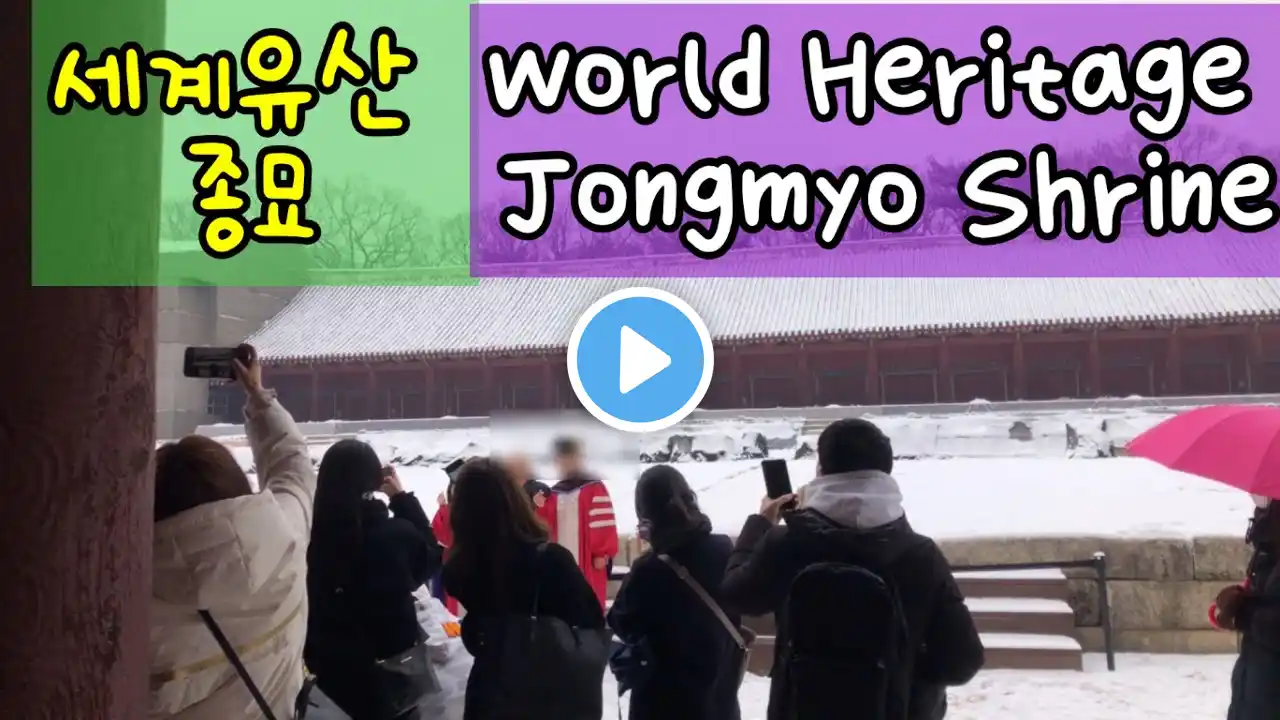
#세계유산종묘 #worldheritage#jongmyoshrine
종묘 종묘는 건물과 더불어 제례 및 제례악을 그대로 보존하고 있습니다. 이러한 이유로 종묘는 1995년에 유네스코 ‘세계유산’으로 등재되었고, 종묘제례 및 종묘제례악은 2001년에 ‘인류무형문화유산’으로 등재 되었습니다. 종묘 제례는 왕이 친히 행하는 가장 격식이 높고 큰 제사로서 정전에서는 일 년에 다섯번, 영녕전에서는 봄, 가을에 두번 지냈습니다. 유학을 통치기반으로 하여 건국한 조선왕조가 1394년에 10월 한양으로 도읍을 옮긴 그해 12월에 정전을 착공하여 1395년 9월에 완공 하였으며, 곧 이어 개성으로부터 태조의 4대조인 목조, 익조, 도조, 환조의 신주를 모셨습니다. 현재 정전에는 19실에 49개의 신주가, 영녕전에는 16실에 34개의 신주가 모셔져 있습니다. 조선시대에는 지금의 정전을 종묘라 하였으나, 현재는 정전과 영녕전을 합쳐 종료라 부릅니다. 정전과 영녕전은 장식과 기교를 절제하여 단조로워 보이지만, 이은 왕실의 제사를 모시는 공간이기에 존엄하고 신성한 분위기를 위한 의도적인 장치입니다. 정문 궁궐 정문 과는 달리 아주 간단하고 소박합니다 삼도 가운데 높은 길인 신로는 조상신이 다니는 길 이고, 오른쪽에는 왕이 다니는 길, 왼쪽은 세자가 다니는 길입니다. 삼도는 울퉁불퉁한 박석으로 깔려져 있는데 이는 이 길을 걸을때 정성스럽게 조심하면서 걸으라는 의미가 담겨있습니다. 지당 일반적으로 궁궐의 못은 연꽃을 심어서 연지라고 부르는데 종묘에 있는 못은 지당이라 부르며 지당은 다른 못과 달리 못에 아무런 식물을 기르지 않으며 물고기도 기르지 않는 것은 신을 받드는 경건함을 유지하기 위한 것입니다. 망묘루 제향때 임금이 머물면서 사당을 바라보며 선왕과 종묘사직을 생각한다는 뜻으로 붙여진 이름입니다. 망묘루는 건물 중 한 칸이 누마루로 되어 있습니다. 향대청 향대청은 종묘에 사용하는 향축폐등 제사 예물을 보관하고, 제향에 나갈 헌관들이 대기하던 곳입니다. 재궁 국왕이 제사를 준비하던 곳입니다. 북쪽에는 임금이 머무는 어재실, 동쪽에는 세자가 머물던 곳이 있고, 서쪽에는 왕이 목욕하는 곳이 있습니다. 정전 정전은 왕과 왕비가 승하 후 궁궐에서 삼년상을 치른 다음에 신주를 옮겨와 모시는 건물입니다. 매칸마다 신위를 모신 신실인 감실 열아홉 칸이 있습니다. 월대 가운데에는 신실로 통하는 긴 신로가 남북으로 나 있으며, 그 북쪽 끝에 상월대와 기단이 설치되어 있습니다. 종묘 건축이 다른 건물과 다른 점은 건물 내부에 모실 신위의 수가 증가함에 따라 몇 차례에 걸쳐 건물을 옆으로 증축하여 길게 늘린 점에 있습니다. 길게 펼쳐진 월대는 안정을, 건물 전면에 무한하게 반복되는 듯한 기둥의 배열은 왕위의 영속을, 수평으로 하늘 끝까지 펼쳐지는 듯한 지붕은 무한을 상징하며, 그 모습은 숭고하고 고전적인 건축미의 극치를 이룹니다. 영령전 영녕전은 신실 하나하나의 구성은 정전과 크게 다름이 없지만 부재의 크기가 정전보다 약간 작고 전체 건물 규모도 정전보다 작지만 친근감을 더 느끼게 합니다. 이 신전은 세종 때 종묘에 모시던 태조의 4대 추존왕인 목조,익조, 도조, 환조와 그 왕비들의 신주를 옮겨 모시기 위해 세워진 별묘로 ‘ 왕실의 조상과 자손이 함께 길이 평한하라’라는 뜻을 담고 있다. 태조의 4대조를 비롯하여 총 34개의 신주가 모셔져 있다. Jongmyo Shrine Jongmyo Shrine preserves the rituals and music as well as the buildings. For this reason, Jongmyo was registered as a UNESCO ‘World Heritage Site’ in 1995, and Jongmyo Jerye and Jongmyo Jeryeak were registered as ‘Intangible Cultural Heritage of Humanity’ in 2001. The Jongmyo rite is the most formal and largest rite performed by the king himself, and was held five times a year at Jeongjeon and twice in spring and autumn at Yeongnyeongjeon. The Joseon Dynasty, founded on the basis of studying Confucianism, moved its capital to Hanyang in October 1394. Construction of the Jeongjeon began in December of the same year and was completed in September 1395. Currently, 49 ancestral tablets are enshrined in 19 rooms in Jeongjeon, and 34 ancestral tablets are enshrined in 16 rooms in Yeongnyeongjeon. In the Joseon Dynasty, the Jeongjeon hall was called Jongmyo, but now Jeongjeon and Yeongnyeongjeon are collectively called Jongmyo. Jeongjeon and Yeongnyeongjeon look monotonous by restraining decoration and finesse, but they are intentional devices to create a dignified and sacred atmosphere as they are spaces for royal ancestral rites. Front Door Unlike the palace main gate, it is very simple and unpretentious. Three-way The high road in the middle is the path for the spirit of ancestors, the right is for the king, and the left is for the crown prince. The three roads are paved with uneven paved stones, which means to walk carefully when walking on this road. Jidang In general, palace ponds are called lotus ponds by planting lotus flowers, but the pond in Jongmyo is called Jidang without any plants or fish just with junipers. Mangmyoru The name was given to mean that the king stayed and looked at the shrine during the time of ancestral rites and thought about the preceding kings. One of the buildings in Manmyoru is made of Numaru. Hyangdaecheong Hyangdaecheong stores sacrificial offerings such as incense sticks, wishing paper used by the magistrates to go to ancestral rites. Jaegung It was the place where the king prepared ancestral rites. To the north is the king's preparing room, to the east is the prince preparing room, and to the west is the king's bathing area. Jeongjeon Jeongjeon is a building where the king and queen are transfered to the shrine and enshrined after the three-year ritual ceremony at the palace after the death of the king and queen. There are nineteen tabernacles. In the middle of Woldae, there is a long Shinro leading to Shinsil, running north and south. What sets Jongmyo's architecture apart from other buildings is that the building has been extended sideways several times to lengthen it several times as the number of shrines to be enshrined inside the building increases. The long-spread Woldae symbolizes stability, the arrangement of columns that seem to repeat indefinitely on the front of the building symbolizes the permanence of the throne, and the roof that seems to stretch out to the end of the sky symbolizes infinity. . Yeongnyeongjeon In Yeongnyeongjeon, the composition of each shrine is the same as that of the main hall, but the size of the members is slightly smaller than that of the main hall but it makes you feel more friendly. This temple was built to enshrine the spirits of the four kings of King Taejo, Ikjo, Dojo, Hwanjo,